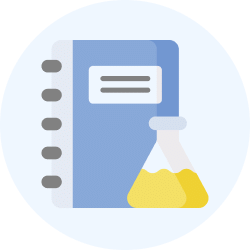NCERT Exemplar Solutions: Nutrition in Animals | Science Class 7 (Old NCERT) PDF Download
| Table of contents |

|
| Multiple Choice Questions |

|
| Very Short Answer Questions |

|
| Short Answer Questions |

|
| Long Answer Questions |

|
Multiple Choice Questions
Q.1. Given below from (i) to (iv) are some food items.
- Boiled and mashed potato
- Glucose solution
- A slice of bread
- Mustard oil
Which of the above will give blue-black colour when tested with iodine?
(a) (i) and (ii)
(b) (i) and (iii)
(c) (ii) and (iii)
(d) (iii) and (iv)
Ans: b
Explanation: Mashed potato and bread are rich in starch. On adding iodine, it reacts with starch to give a blue-black colour.
Q.2. Which of the following pair of teeth differ in structure but are similar in function?
(a) canines and incisors.
(b) molars and premolars.
(c) incisors and molars.
(d) premolars and canines.
Ans: b
Explanation: Our teeth tear, grind the food before swallowing it. There are four types of teeth.
Incisors: There are 8 incisors, four in the upper jaw and four in the lower jaw. They are used for cutting and biting food.
Canines: There are 4 canines, one on each side of each jaw.
Premolars: There are 8 premolars. Two premolars in each of the upper and lower jaws.
Molars: There are 12 molars, three in each half of both upper and lower jaws.
Q.3. Read carefully the terms given below. Which of the following set is the correct combination of organs that do not carry out any digestive functions?
(a) Oesophagus, Large Intestine, Rectum
(b) Buccal cavity, Oesophagus, Rectum
(c) Buccal cavity, Oesophagus, Large Intestine
(d) Small Intestine, Large Intestine, Rectum
Ans: a
Explanation: The Oesophagus pushes the food downwards and it is not involved in any digestive functions.
Large intestine absorbs water and some salts from the undigested food material, and it is not involved in the digestion process.
In the rectum, remaining waste passes and remains there as semi-solid faeces. It is not involved in any digestive function.
Q.4. The swallowed food moves downwards in the alimentary canal because of
(a) force provided by the muscular tongue.
(b) the flow of water taken with the food.
(c) gravitational pull.
(d) the contraction of muscles in the wall of the food pipe.
Ans: d
Explanation: Muscles of the Oesophagus push food down by the movement of the wall of the food pipe. Actually, this movement takes place throughout the alimentary canal and pushes the food downwards.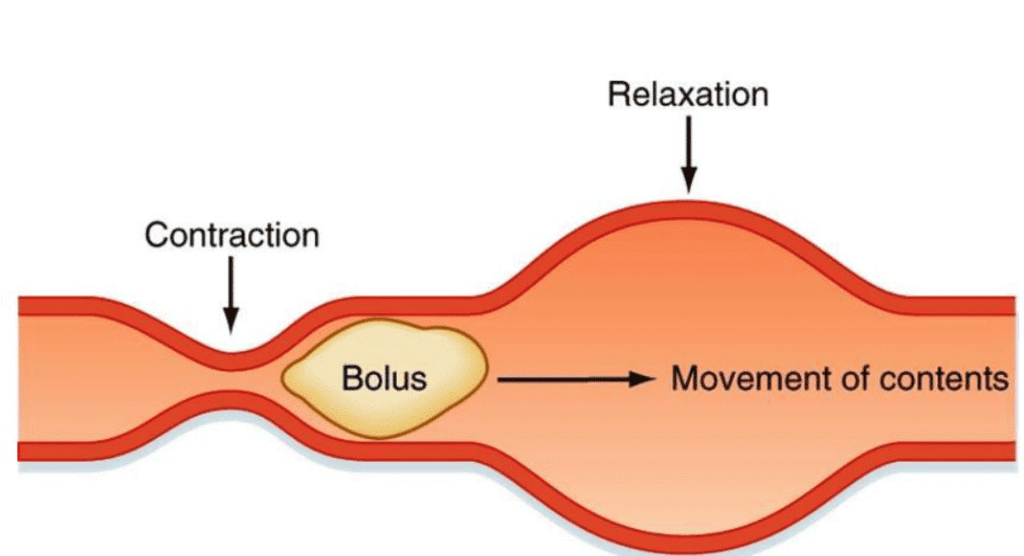
Q.5. The acid present in the stomach
(a) kills the harmful bacteria that may enter along with the food.
(b) protects the stomach lining from harmful substances.
(c) digests starch into simpler sugars.
(d) makes the medium alkaline.
Ans: a
Explanation: The stomach consists of Hydrochloric acid, which kills the bacteria that enter through food. Thus, stomach acid is helping in protecting us from harmful bacteria.
Q.6. The finger-like outgrowths of Amoeba help to ingest food. However, the finger-like outgrowths of human intestine help to
(a) digest the fatty food substances.
(b) make the food soluble.
(c) absorb the digested food.
(d) absorb undigested food.
Ans: c
Explanation: Fingerlike projections are present in the small intestine and they are called Villi. They absorb nutrients from digested food by increasing the space of the small intestine.
Q.7. Read the following statements with reference to the villi of the small intestine.
(i) They have very thin walls.
(ii) They have a network of thin and small blood vessels close to the surface.
(iii) They have small pores through which food can easily pass.
(iv) They are finger-like projections. Identify those statements which enable the villi to absorb digested food.
(a) (i), (ii) and (iv)
(b) (ii), (iii) and (iv)
(c) (iii) and (iv)
(d) (i) and (iv)
Ans: a
Explanation:
Inner walls of the small intestine have thousands of finger-like outgrowths called villi (singular villus). Villi increase the surface area for absorption of the digested food. Each villus has a network of thin and small blood vessels close to its surface. The surface of the villi absorbs the digested food materials. The absorbed substances are transported via the blood vessels to different organs of the body where they are used to build complex substances such as the proteins required by the body.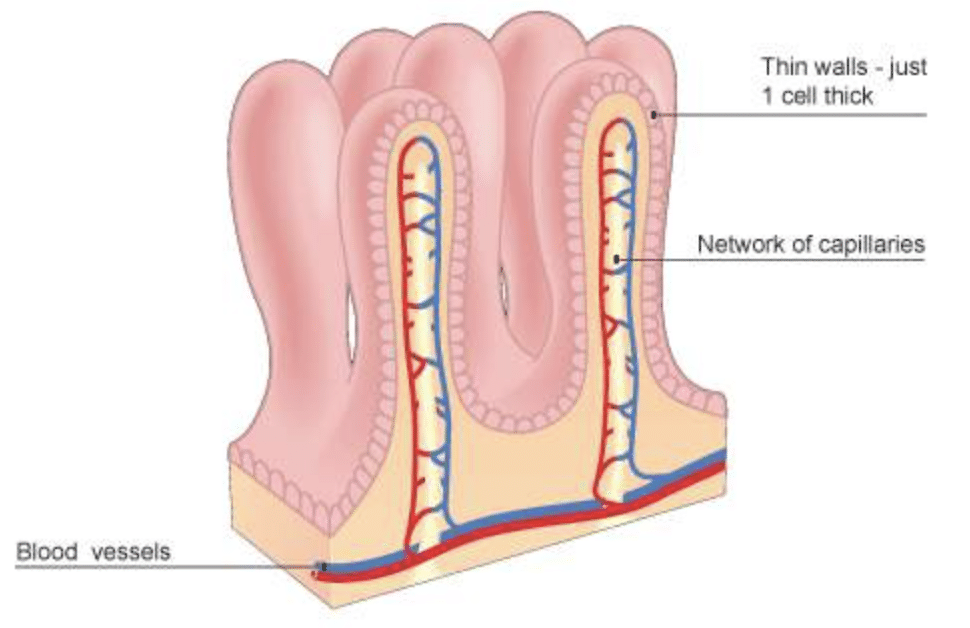
Q.8. The false feet of Amoeba is used for
(a) movement only.
(b) the capture of food only.
(c) the capture of food and movement.
(d) exchange of gases only.
Ans: c
Explanation:
Amoeba constantly changes its shape and position. It pushes out one, or more finger-like projections, called pseudopodia or false feet, for movement and capture of food. Amoeba feeds on some microscopic organisms. When it senses food, it pushes out pseudopodia around the food particle and engulfs it.
Q.9. The enzymes present in the saliva convert
(a) fats into fatty acids and glycerol.
(b) starch into simple sugars.
(c) proteins into amino acids.
(d) complex sugars into simple sugars.
Ans: b
Explanation: Saliva consists of salivary amylase enzyme, which breaks starch into simple sugars, which is further digested by enzymes in the stomach and small intestine.
Q.10. Cud is the name given to the food of ruminants which is
(a) swallowed and undigested.
(b) swallowed and partially digested.
(c) properly chewed and partially digested.
(d) properly chewed and completely digested.
Ans: b
Explanation: Ruminants quickly swallow the grass and store it in a part of the stomach called the rumen. Here the food gets partially digested and is called cud. But later the cud returns to the mouth in small lumps and the animal chews it. This process is called rumination.
Q.11. Choose the correct order of terms that describes the process of nutrition in ruminants.
(a) swallowing → partial digestion → chewing of cud → complete digestion
(b) chewing of cud → swallowing → partial digestion → complete digestion
(c) chewing of cud → swallowing → mixing with digestive juices → digestion
(d) swallowing → chewing and mixing → partial digestion → complete digestion
Ans: a
Explanation: The correct order of terms that describes the process of nutrition in ruminants is:
- Ingestion of food into the rumen
- Food is stored and later returned to the mouth for chewing
- Digestion occurs in the small intestine, followed by absorption
Q.12. Cellulose-rich food substances are a good source of roughage in human beings because
(a) human beings do not have cellulose-digesting enzymes.
(b) cellulose gets absorbed in the human blood and converts into fibres.
(c) the cellulose-digesting bacteria convert cellulose into fibres.
(d) cellulose breaks down into smaller components, which are egested as roughage.
Ans: a
Explanation: Cellulose-rich food substances are beneficial for human health because they provide roughage, which aids digestion.
Very Short Answer Questions
Q.13. Name the parts of the alimentary canal where
(i) Water gets absorbed from undigested food.
(ii) Digested food gets absorbed.
(iii) Taste of the food is perceived.
(iv) Bile juice is produced.
Ans:
(i) Large intestine
(ii) Small intestine
(iii) Tongue
(iv) Liver
Q.14. Mark the following statements as True or False. If false, write the correct statements
(a) The tongue is attached to the roof of the mouth cavity at the back.
(b) The large intestine is longer and wider than the small intestine of the human alimentary canal.
(c) Mucus protects the stomach lining from damage.
(d) All heterotrophs have a similar basic process of nutrition.
Ans:
False- The Tongue is attached to the floor of the mouth cavity at the back.
False – The large intestine is shorter and wider than the small intestine of the human alimentary canal.
True
True
Q.15. Choose the odd one out from each group and give reasons.
(i) liver, salivary gland, starch, gall bladder
(ii) stomach, liver, pancreas, salivary gland
(iii) tongue, absorption, taste, swallow
(iv) oesophagus, small intestine, large intestine, rectum
Ans: (i) Starch is the odd one out because it is a carbohydrate, while the liver, salivary gland, and gall bladder are all glands.
(ii) Stomach is the odd one out as the others are digestive glands.
(iii) Absorption is the odd one out since the tongue, swallowing, and taste are related to the buccal cavity, but not to absorption.
(iv) Small intestine is the odd one out because the oesophagus, large intestine, and rectum do not participate in digestion, while the small intestine is crucial for this process.
Q.16. You were blindfolded and asked to identify the drinks provided in two different glasses. You could identify drink A as lime juice and B as bitter gourd juice. How could you do it in spite of being blindfolded?
Ans: We can identify the juices with the help of different taste buds present in the tongue. The tongue has areas that are sensitive to different tastes, allowing us to distinguish between them.
- Lime juice is typically sour, which activates specific taste buds.
- Bitter gourd juice has a distinct bitter taste that is also recognised by our taste buds.
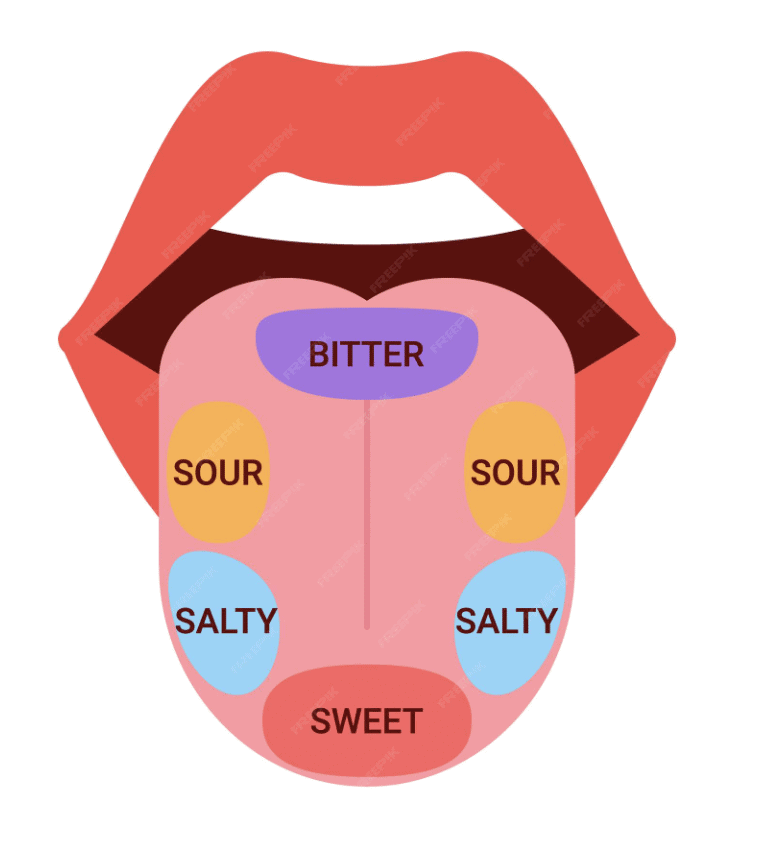
Q.17. Fill in the blanks with suitable words:
(a) The alimentary canal stretches from____________ to_____________.
(b) Teeth are rooted in separate _____________ in between the_____________.
(c) Digestion of food starts in _____________ and gets completed in _____________.
(d) _____________ is the largest gland in the human body.
Ans: (a) The alimentary canal stretches from Mouth to Anus.
(b) Teeth are rooted in separate Sockets in between the Gums.
(c) Digestion of food starts in the Buccal cavity and gets completed in the Small Intestine.
(d) The liver is the largest gland in the human body.
Q.18. Following statements describe the five steps in animal nutrition. Read each statement and give one word for each statement. Write the terms that describe each process.
(a) Transportation of absorbed food to different parts of the body and their utilisation.
(b) Breaking of complex food substances into simpler and soluble substances.
(c) Removal of undigested and unabsorbed solid residues of food from the body.
(d) Taking food into the body.
(e) Transport of digested and soluble food from the intestine to blood vessels.
Ans:
(a) Assimilation
(b) Digestion
(c) Egestion
(d) Ingestion
(e) Absorption
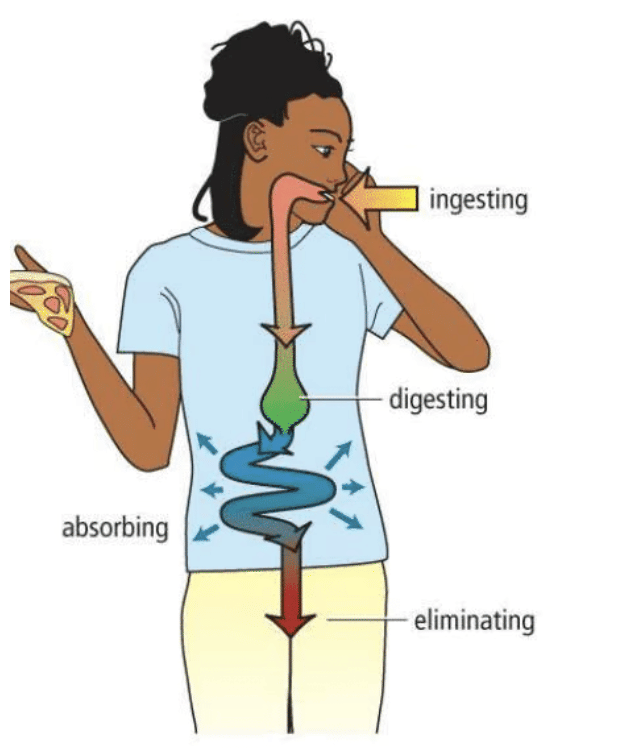
Short Answer Questions
Q.19. Match the animals in Column I with their mode of feeding listed in Column II

Ans:
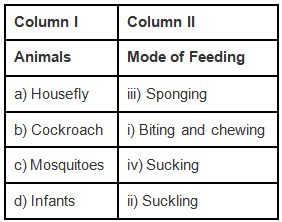
Q.20. Boojho took some grains of boiled rice in a test tube ‘A’ and Paheli took boiled and chewed rice in a test tube ‘B’. Both of them poured 1 – 2 drops of iodine solution into the test tube and observed the colour change. What colour change would they have observed? Give reasons for your answer.
Ans: In test tube A, the iodine changes to blue-black due to its reaction with starch. This indicates the presence of starch in the boiled rice. In test tube B, there is no colour change because salivary amylase in saliva breaks down the starch into simpler sugars while chewing.
Q.21. ‘A’ got her gall bladder removed surgically as she was diagnosed with stones in her gall bladder. After the surgery, she faced problems in the digestion of certain food items when consumed in bulk. Can you tell which kind of food items would they be and why?
Ans: Those foods will be fats because bile juice, which is stored in the gall bladder, is essential for fat digestion. After the gall bladder is removed, digesting fats becomes more challenging.
- Fats are harder to digest without bile.
- Foods high in fat may cause discomfort if consumed in large quantities.
Q.22. Match the organs in Column I with the words listed in Column II.
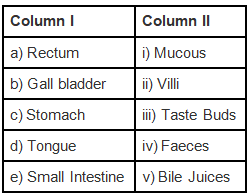
Ans:
Q.23. Ruminants such as cows and buffaloes swallow their food hurriedly and then sit restfully and chew their food. Can you reason why?
Ans: Ruminants, such as cows and buffaloes, have a unique way of digesting their food. They quickly swallow their food and store it in a special stomach compartment called the rumen. Later, they bring the food back to their mouth in small lumps, known as cuds, and chew it thoroughly. This process is called rumination and helps them digest their food completely.
- Ruminants swallow food quickly to store it.
- The food is partially digested and forms cuds.
- They chew the cuds later for better digestion.
- This method allows them to extract more nutrients from their plant-based diet.
Q.24. Boojho and Paheli were eating their food hurriedly so that they could go out and play during the recess. Suddenly, Boojho started coughing violently. Think of the reasons why he was coughing and discuss with your friends.
Ans: Sometimes, when you eat quickly, talk, or laugh while eating, you may cough. This can happen because:
- The epiglottis, a flap-like valve, may not close properly.
- Food particles can accidentally enter the windpipe, which carries air to the lungs.
- Coughing helps to clear the windpipe and prevent choking.
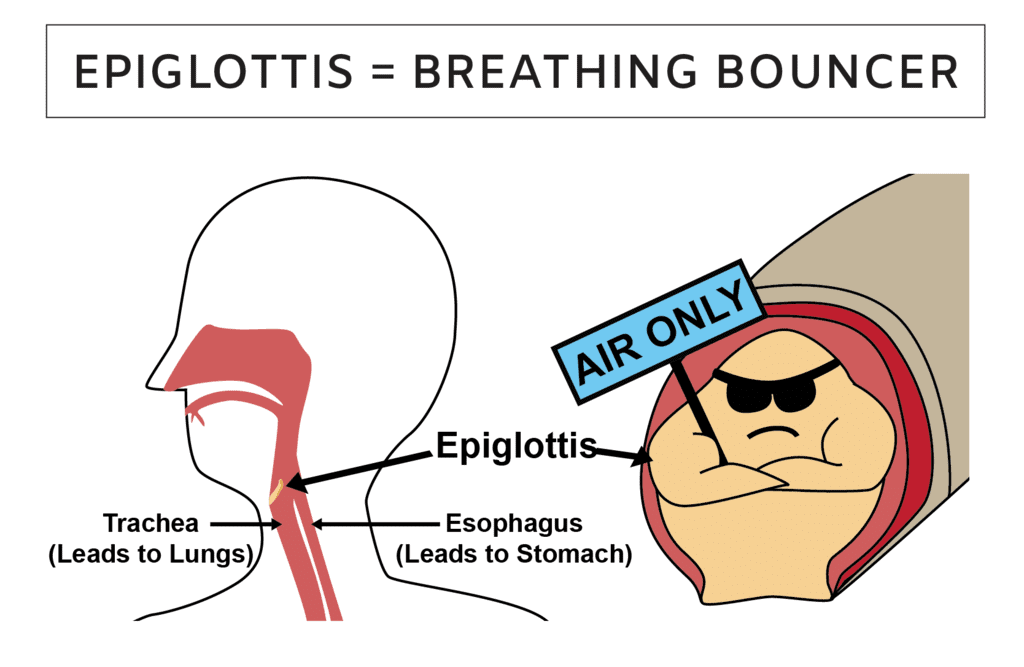
In summary, eating hurriedly can lead to coughing as a reflex to protect the airways.
Long Answer Questions
Q.25. Fill in the blanks using the words listed below.
water, front, intestinal, salts, pseudopodia, back, vacuole
(a) The digestion of all food components is completed by the ____________ juice.
(b) Large intestine absorbs __________ and some __________ from the undigested food.
(c) Tongue is attached at the _____________ to the floor of the mouth cavity and is free at the _____________.
(d) Amoeba pushes out _____________ around the food and traps it in a food _____________.
Ans:
(a) The digestion of all food components is completed by the Intestinal juice.
(b) Large intestine absorbs water and some salts from the undigested food.
(c) Tongue is attached at the back to the floor of the mouth cavity and is free at the front.
(d) Amoeba pushes out Pseudopodia around the food and traps it in a food vacuole.
Q.26. Label the below given Figure as directed below in (i) to (iv) and give the name of each type of teeth.
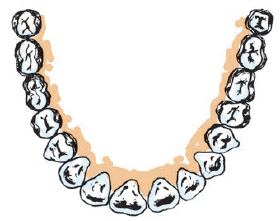
(i) The cutting and biting teeth as ‘A’
(ii) The piercing and tearing teeth as ‘B’
(iii) The grinding and chewing teeth as ‘C’
(iv) The grinding teeth present only in adult as ‘D’
Ans:
A. Incisors
B. Canines
C. Premolars
D. Molars
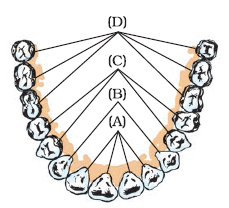
Q.27. Read the following passage carefully and answer the questions that follow it. Bile juice is stored in a sac called, gall bladder, located near its organ of secretion, liver. The gall bladder releases the bile juice into the small intestine whenever food reaches there. Though bile juice is devoid of any digestive enzymes, it is required for the digestion of fats. The fats cannot be digested easily because they are insoluble in water and are present as large globules. Bile juice breaks down big fat droplets into smaller droplets. These are then easily digested by the enzymes released from the pancreas.
(a) Which organ secretes the bile juice?
(b) Why is digestion of fats difficult as compared to that of other nutrients?
(c) How does bile juice help in digestion of fat?
(d) Where is the digestion of fat completed?
(e) Does bile juice digest fat completely?
Ans:
(a) Liver
(b) Insolubility of fat in water.
(c) Breaks down big fat droplets into smaller droplets.
(d) Small intestine
(e) No
Q.28. Label the following parts in Figure and name them.
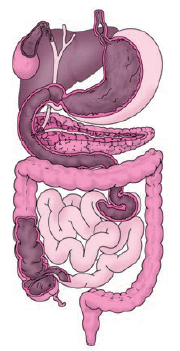
(a) The largest gland in our body.
(b) The organ where protein digestion starts.
(c) The organ that releases digestive juice into the small intestine.
(d) The organ where bile juice gets stored.
Ans:
(a) Liver
(b) Stomach
(c) Pancreas
(d) Gall bladder
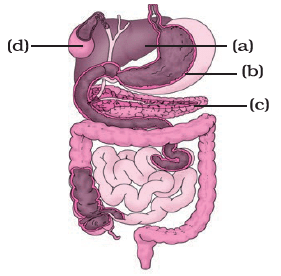
Q.29. Solve the crossword given in Figure
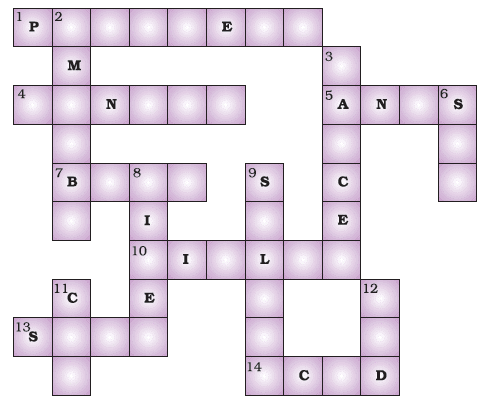
Across
1. Cream-coloured digestive gland
3. Undigested excretory solid residues
4. An organ that mixes saliva with the food
5. Point of defecation
7. Stored in the gall bladder
10. Finger-like outgrowth in the small intestine
13. Kind of taste buds
14. Kills bacteria in the stomach
Down
2. Feeds with the help of pseudopodia
6. Total number of molars in one jaw of an adult
8. Largest gland
9. Watery secretion in the mouth
11. A ruminant
12. Form of food chewed by ruminants
Ans:
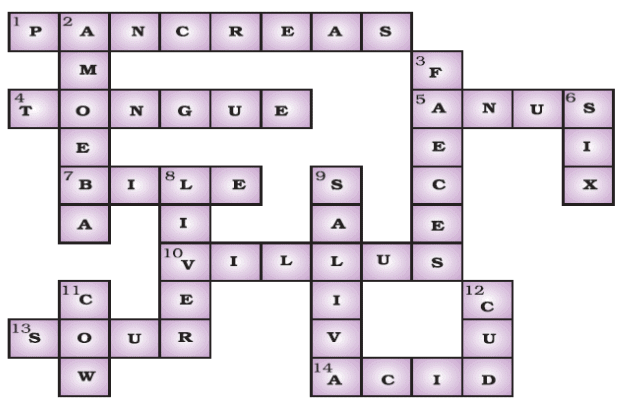
|
112 videos|286 docs|28 tests
|
FAQs on NCERT Exemplar Solutions: Nutrition in Animals - Science Class 7 (Old NCERT)
| 1. What is the process of nutrition in animals? |  |
| 2. How do animals obtain their food? |  |
| 3. What is the role of digestion in animal nutrition? |  |
| 4. How is food digested in the digestive system of animals? |  |
| 5. What happens to the undigested food in animals? |  |




